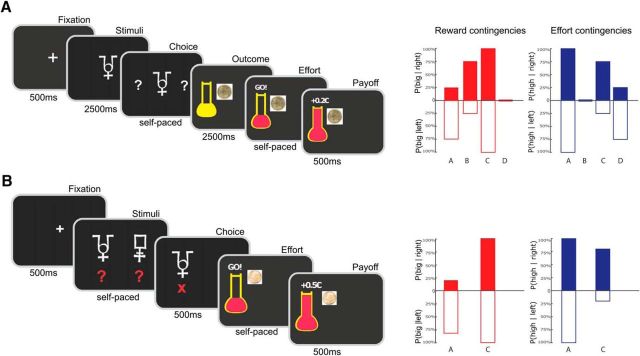Figure 1.
Behavioral tasks used in Study 1 (A) and Study 2 (B). Successive screenshots from left to right illustrate the timing of stimuli and responses for one example trial. When interrogation dots appeared on screen, subjects had to choose between right and left options. Each option was associated with both monetary reward and physical effort. For the chosen option only (left in the example), reward level was indicated by an image of corresponding coin and effort level by the horizontal bar on the thermometer. At the GO! signal, subjects had to squeeze the chosen handgrip (left in the example) until the red fluid level reached the horizontal bar. At that moment, subjects were notified that the reward was added to their cumulative payoff. Changes between the two studies relate to the symbolic cues (one per condition in Study 1 vs one per option in Study 2), the timing (subjects had to wait for a fixed delay before responding in Study 1, whereas they could choose and squeeze as soon as cues and outcomes were displayed in Study 2), and the reward levels (10¢ and 20¢ in Study 1 vs 10¢ and 50¢ in Study 2). Effort levels (20% and 80% of maximal force) were unchanged. Bar graphs on the right illustrate the contingencies between symbolic cues and both reward (red) and effort (blue) outcomes (left and right graphs). Bars indicate the probability of getting high reward/effort outcomes (or one minus the probability of getting low reward/effort outcomes) for left and right options (empty and filled bars, below and above the x-axis). In Study 1, there were four different contingency sets cued by four different symbols (A–D), whereas in Study 2, there were only two contingency sets cued by two different pairs of symbolic cues (A, C). In each contingency set, one dimension (reward or effort) was fixed such that learning was only possible for the other dimension. Reward learning was assessed by red sets (A, B in Study 1; A in Study 2) and effort learning by blue sets (C, D in Study 1; C in Study 2). The illustration only applies to one task session. Contingencies were fully counterbalanced across the four sessions.

